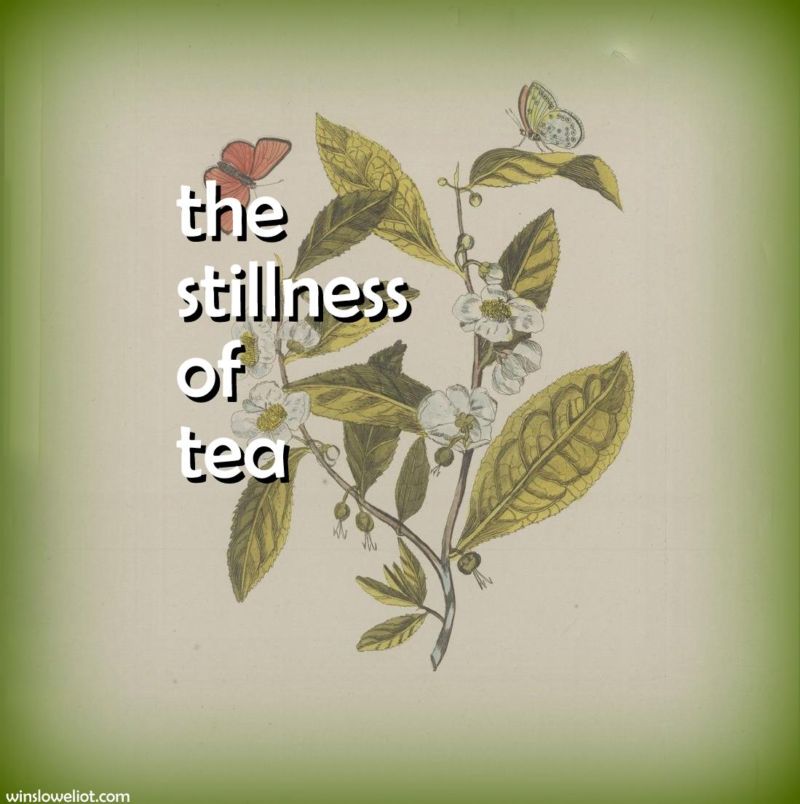
Stillness 9-14: I’ve always made a pot of tea at around four o’clock, having lived so many years in England, and it being the afternoon ritual when I came home from school. Our family sometimes did tea-tastings, including blind tastings (I became very good at determining Lapsang Soochong from Formosa Oolong in these tastings—not difficult, but still great fun). But it’s only recently that I’ve fallen into serious, all-day-and-into-the-evening Camellia sinensis drinking.
Recently, on a whim and only because it was on a special sale, I listened to the audio book version of Infused—Adventures in Tea, written (and read) by Henrietta Lovell. Her passion for tea, as well as her wonderful descriptions of the people and places she has encountered on her search for sustainable, pure, community-enhancing tea farms around the world, warmed my heart and set me on this tea-inspired journey to well-being. Now I’m reading more books and trying all kinds of Camellia sinensis—green, white, black, oolong … and I’m looking forward to trying matcha one of these days. There’s so much to try. So many tastes and experiences. And each cup I drink enhances in me a greater sense of my other passion, which is, of course, Stillness.
In my book Be Still—how to heal and grow I talk about the four elements in connection to the wellbeing of our four “bodies”: physical, mental, emotional, and spiritual. Tea-drinking nourishes and enhances all four of these parts of us. Physically, it has enormous health benefits. Mentally, it keeps us alert and focused. Emotionally, it calms us and lifts our mood at the same time. Spiritually, it’s been used for ritual, teaching, and meditation in Buddhist centers for many centuries.
Let’s look at our physical—earth—body first: Tea is full of polyphenols, which have potent antioxidant benefits. They’re also powerful anti-inflammatories, the source of many chronic diseases. The polyphenols can boost our metabolism, which helps burn calories and reduces body fat. Tea also has an amino acid called theanine which increases our white blood count—a good preventive when we feel the onset of a cold. They’re also excellent aids for our essential gut health. And did you know that tea contains fluoride (I didn’t!)—fluoride is great in helping to keep our lovely mouths healthy and strong.
Mental—air—body: Tea is good for our mental well-being. It improves reaction time, memory, and concentration. If you’re studying for an exam, tea helps you focus for longer periods of time, without the crash that coffee can give you. This is why the monks in temples, required to meditate for hours at a time, sipped tea all day. Tea also inspired poets and artists from earliest times. And it nurtures our brain and may help prevent or delay cognitive diseases like dementia and Alzheimer’s as we age.
Emotional—water—body: Tea is not only physically hydrating (drinking six to eight cups of tea a day is as hydrating as drinking the same amount of water) but it also hydrates our emotions. We feel cozier, stronger, calmer, more relaxed, and happier drinking tea. This may be because it contains an amino acid called theanine, which reduces stress. It also lowers the risk of depression because it lowers our levels of the stress hormone cortisol. Combined with the caffeine that’s in tea, our brain and our mood are lifted, giving us a profound feeling of relaxation. It’s so interesting that tea has the double effect of making us feel calm and invigorated at the same time.
Spiritual—fire—body: The rich spirituality of tea goes back to its millenia-old beginnings, when culture, religion, and tea were intertwined in a complex and fascinating history. In Japan, tea ceremonies centered around “reverence, respect, purity, and tranquility.” In the famous The Book of Tea, Okakura Kakuz? talks about “Teaism” and addresses how Buddhism, Confucianism, and Taoism has all streamed into “Teaism” and the art of tea-making and drinking.
My own spirituality is centered around connecting with Source through stillness, so I have one more thought about tea to share: In our venturing into the great adventure of stillness, we experience healing Source. We become aware of being aware. When we are aware of the source of things, everything matters. Where did this sip of tea come from? Who made it, under what conditions, and were they fairly compensated for their labor? I’ve found out a lot about the tea business in my explorations, and I know I will never purchase another polluting tea bag nor tea that comes from a large industrial tea farm. I’ve tended to gravitate toward labels of “organic” and “fair trade,” not realizing that often only huge corporations can afford to pay for that labeling. I want to support small farms that care about their communities, their workers, and, of course, their tea. So before you buy tea, find out where it’s sourced. I have grown particularly fond of the Rare Tea Lady, aka Henrietta Lovell, mostly because of her book and ethics, but I’m sure there are plenty of other small tea companies that care as passionately as she does about where their tea comes from, the lives of the farmworkers, how the tea is grown and processed, as well as how good it tastes. When we know the source is good, we feel good.
